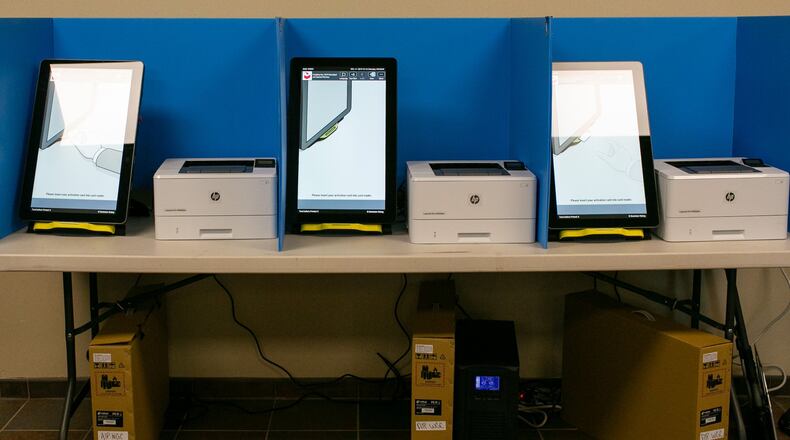Georgia taxpayers could be saddled with tens of millions of dollars in hidden costs for new voting machines, according to calculations released Wednesday by three groups critical of the state's election spending.
The groups, which span the political spectrum, said a $104 million contract for a new statewide voting system fails to provide enough money for voting machines, equipment, software and personnel, resulting in an estimated $82 million shortfall.
The Georgia secretary of state’s office responded that the groups’ estimates are incorrect, the voting system is within its budget, and the state government has already ordered 3,000 additional machines to meet voters’ needs.
The cost analysis was produced by Fair Fight Action, a voting rights group founded by former Democratic nominee for governor Stacey Abrams; FreedomWorks, which advocates for free markets and small government; and the National Election Defense Coalition, an election security organization.
“By imposing this unfunded mandate, the secretary of state has put all 159 counties in a position of either enacting massive local tax hikes or facing widespread lawsuits at taxpayer expense,” said Jason Pye of FreedomWorks.
Georgia could be heading toward “another poorly executed election” if officials lack enough voting equipment, said Lauren Groh-Wargo, the CEO for Fair Fight Action.
“The secretary of state is sweeping these costs under the rug, but the counties will be on the hook for them,” said Susan Greenhalgh of the National Election Defense Coalition.
Secretary of State Brad Raffensperger declined to comment Wednesday.
The groups alleged that county governments will have to buy additional voting machines to comply with a new state law that requires one voting booth per 250 voters. Those costs amount to $7.3 million next year and an additional $9.3 million over the next decade to keep up with population growth, the groups said.
But Raffensperger’s office said Wednesday that it has already anticipated the requirement for enough voting machines. The state recently increased its initial order of 30,050 voting machines to 33,100 while remaining under the $150 million allocated by the General Assembly for the voting system.
At $3,500 per voting machine, that adds up to a cost of nearly $10.7 million.
The groups also said county governments may be responsible for $47 million in warranty and licensing costs, along with $18 million in printing and personnel costs.
Those figures are inaccurate, according to the secretary of state’s office. Warranties are optional for counties, and personnel costs could actually decline because the paper-based part of the voter check-in process will likely be eliminated.
The new voting system, manufactured by Denver-based Dominion Voting Systems, is scheduled to be rolled out statewide in time for the March 24 presidential primary. It will replace Georgia’s 17-year-old machines, which lack a paper ballot.
Voters will select their candidates on touchscreens, similar to how they currently make their choices. The new touchscreens will be connected to printers that will produce a ballot for voters to review. They’ll then be able to insert their ballots into scanning machines for tabulation.
The General Assembly approved up to $150 million this year for the voting system, but the competitively bid contract came in about $46 million lower than that amount. The contract will likely be amended to cover additional items.
County governments recognize that they will be responsible for costs of paper, ink cartridges and warranties, but they’re grateful that Georgia’s state government covers the most expensive voting equipment, said Todd Edwards of the Association County Commissioners of Georgia, which advocates for county governments.
In other states, counties have to pay for most of their election equipment.
“There will always be costs to counties so long as counties operate federal, statewide and local elections,” Edwards said. “Democracies cost money. We’re more than happy that the state is willing to appropriate that money, and we’re willing to work with them.”
During a test run of the voting system in six counties last month, election officials reported several problems with checking in voters, ballot scanners and touchscreens.
The secretary of state's office has said most of those issues were caused by human error and will be resolved before the presidential primary.
About the Author
Keep Reading
The Latest
Featured




